Midwinter Wandering -- Travel Overview
9 February 2006
We've been traveling for over a month now, for better or for worse, in sickness and in health, and now are in Lijiang briefly before heading out on our final excursion before classes start (yes, we will have to work again). Eventually, I'll post in detail on our adventures but for now here is a collection of photos from along the way and a little sense of where we've been. We're off shortly on one last trek and will start posting regularly once we return and get class preparation under control.
As Ellen jetted to Denver/Boulder/Laramie for a week's visit, Bei and I began our holiday journey with a quick (45 minute) flight from Lijiang to Kunming, the capitol of Yunnan, where we took advantage of the availability of western food and the dubious charms of a big city. Kunming is thriving and these salespeople were receiving a morning pep rally as Bei and I wandered by on our way to find a ride to the Bamboo Temple.
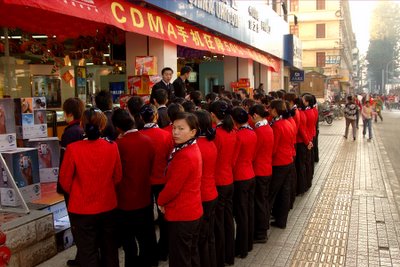
Alan Greenspan's legacy goes far beyond his accomplishments at the Fed. Here, on the eve of his retirement, his photograph, along with the newspaper that it is printed on, is taped to a temple window to protect busy monks from the distracting glare of the sun. You are not forgotten, Alan.

Kunming was but a waystation on our way to Thailand and Bei and I were soon airborne again for the two hour flight to Bangkok. We arrived after dark, hot and tired, and made our way to Khao San Rd. to find our guest house which was nearby but not on Khao San proper. As I struggled through throngs of dreadlocked "backpacker tourists" carrying a large climbing pack and a smaller pack and towing a tired Bei behind me, I heard a voice calling my name. Matt Williams, a Laramie climbing friend, is in Bangkok shooting photos at an AIDS hospice for children and happened to see me as I lumbered by. We met for dinner later in our stay. You can see Matt's excellent photographs at http://www.photoshelter.com/user/mathewphoto. The following day, Bei catches up on her sleep in the guesthouse lobby while I make arrangements for our travel north to Chiang Mai (this time by sleeper train).

Chiang Mai lies in the heart of the hill country of northern Thailand where I had promised Bei elephant rides. Elephants have been a traditional work animal in this part of Thailand and they are still used, though their value as a tourist attraction probably surpasses their ability to carry logs. To fulfill my promise we signed on for a tourist tour of the area near Chiang Mai and enjoyed a rather pedestrian day of elephant riding, bamboo raft floating and visits to small ethnic villages converted to centers for tourist sales. But it was fun and Bei was delighted by the elephant, which gently accepted sugar cane and bananas from her after she alerted him to food with a gentle tap to his ear as we rode.

Boldly, I took a stab at escaping Chiang Mai using a rented motor scooter. Riding in Chiang Mai traffic with a 4-year old is less than ideal and I was soon in a cold sweat despite the heat as I imagined Ellen's horror had she seen us hurtling down chaotic highways in a land where, disorientingly, they drive on the left side of the road. By the time we reached this temple on the edge of town, I'd had enough and stopped to chill out and regroup for the trip back into town. Bei was unperturbed and looked forward to the next leg of our journey. I wandered around the temple grounds sweating and figuring the odds of our returning the bike and ourselves unscathed to the rental place. Later I saw foreigners, scraped and shaken but otherwise ok, picking themselves up off the street after crashing their substantially larger machine.

Painted forked sticks apparently have religious significance and these were common on the temple grounds where they were arranged around trees that were themselves wrapped in sashes.

Back in Bangkok to meet Ellen after her whirlwind trip to the U.S., we found that Ronald MacDonald also has religious sensitivity in Thailand where he implores travelers to enter and pay homage to the quarter pounder.

Ellen arrived late at night at the Bangkok airport, where Bei and I met her, tired from a whirlwind week of socializing in Denver, Boulder and Laramie. The next day, we visited, of all places, Chinatown, where these pigs awaited conversion into Chinese food. Later we found our way into India-town where we enjoyed our first truly good Indian food since leaving the U.S. in July.

These fish decorated another area near Chinatown.

A typical Bangkok business, seen from the street.

Another short flight (1 hour) took us south to Krabi and a short longtail boat ride deposited us at Tonsai/Railay beach, our primary Thai destination for two weeks of climbing and swimming. I'd spent 2 months here in 1996 and Tonsai has changed. Once empty but for a small group of bamboo bungalows, the beach is now lined with restaurants and fancier bungalows and overwhelmed by throngs of climbers seething over everything from steep rock to espresso bars. Despite the changes, we had fun climbing easy routes (all we could manage) and swimming. Bei reveled in the availability of water (there is no pool in Lijiang) and swam almost continuously in the warm Andaman Sea and in the pool at our bungalow complex.
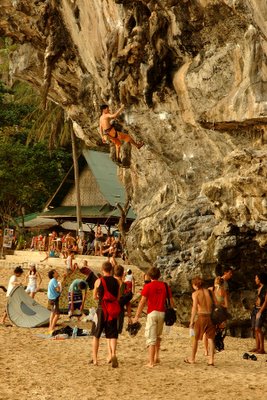
The climbing at Tonsai and Railay is unique in the world and though difficult routes were beyond us after 6 months away from rock, we could at least watch hard climbing while we sipped coconut shakes on the nearby restaurant patio. This local climber is working on one of the steep Tonsai routes. The tsunami a year ago surged higher than the climber in the photo (we are told), but this particular area was fortunate to have been sheltered by islands and reefs and damage was not severe (though people were certainly killed). Other nearby areas (e.g., Koh Pi Pi) were devastated.

Hanging on the rope was a regular posture for us as it was for this climber at Tonsai, though we managed to hang on much less difficult terrain.
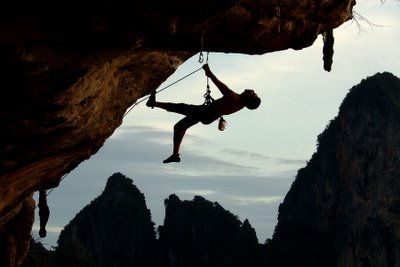
Warning parents: brief nudity. The beautiful white sand beaches of southern Thailand are a magnet for vacationers from all over the world with a high concentration of European tourists used to the relatively liberal bathing suit norms of the Mediterranean Coast. Although Thais are offended by nudity, it is tolerated/ignored on the beaches of Railay, in part because this area is an isolated tourist area accessible only by boat. Though I refrained from pointing my telephoto lens at topless bathers, in the photo below Bei demonstrates the swimming scene at the beach.

A rest day adventure took us, again by motor scooter, though in sparse rural traffic, to the Tiger Cave temple area near Krabi where we explored beautiful forest, interesting monastic caves and an associated temple. Here Ellen and Bei check out one of the huge buttressed trees.
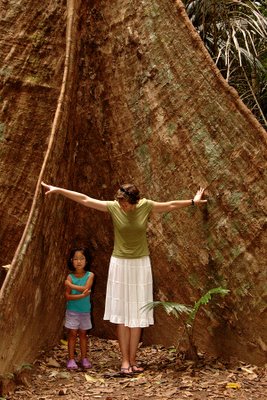
Another tree with religious sashes among the roots.
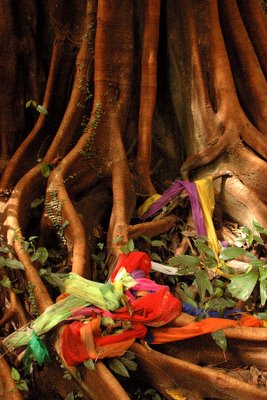
You parents will be relieved to see that riding motorcycles in foreign countries is perfectly safe for children. Here Bei demonstrates her safety equipment which nearly fit.

And here we are on our "big iron" returning from Tiger Cave with local/fellow "bikers" raucously showing their respect and comraderie. Photo by Ellen.

All tropical things must come to an end (or be consumed by decomposition) and with mixed feelings we left southern Thailand, returned to Bangkok, flew back to Kunming and then hopped by plane to the city of Jinghong in the Xishuangbanna region of southern Yunnan. Xishuangbanna had been described to us a "beautiful" and "interesting" but, though we did not spend enough time here to fairly pass judgement, the image of Marlon Brando muttering "the horror, the horror" as he sweated in his jungle kingdom kept echoing in my mind as we stumbled from road construction to village wife beatings to alcoholic ethnic ceremonies. Jinghong sits beside the Mekong River and the night market below was a hybrid of a carnival, a food market and a collection of seedy bars.

The food looked good, though I had already eaten by the time I wandered this market.

We rented bicycles (in China foreigners don't generally rent motorized vehicles) and rode through some nice countryside across the river from Jinghong.

The countryside around Jinghong is dominated by rice paddies in the flats and rubber tree plantations in the hills. Little original forest remains in this part of Xishuangbanna, though I read that further afield there is more to be found. A road connecting Bangkok to China is under construction here, and the construction follows the route of several popular treks as we were soon to discover.

We spent the Chinese New Year in Jinghong, where gifts like this fine coffee sampler were for sale. If any of you out there in Peets/Starbucks/Green Mountain-land are hankering after some fine instant Nescafe, just drop me an e-mail and I'll see what I can ship you. My best description of Chinese New Year is that it evokes the feeling one must have had in London during WWII when the German's were bombing heavily.
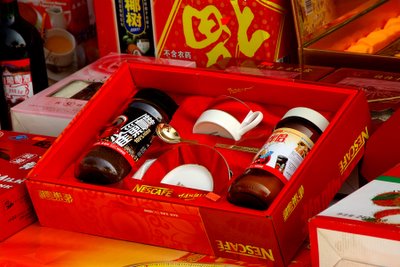
Escaping the city and getting out on foot is always the solution to travel weariness and we set off with enthusiasm and a local English-speaking guide (who told us that he "loved nature") on a two-day trek that promised "rice paddies, jungle, and ethnic villages." Here we are on day one of our trek, enjoying the heavy equipment of the Bangkok to China highway. The horror; The horror.

This kind lady, who reminded me of the flying monkeys from the Wizard of Oz (which we were reading to Bei at the time), welcomed us onto her patio for snacks and the local moonshine, called baijou (a "wine" typically made from sorghum or corn with an alcohol content of about 50%). She could toss back some of the latter with a grimace and an impish laugh and she was a good sharer.
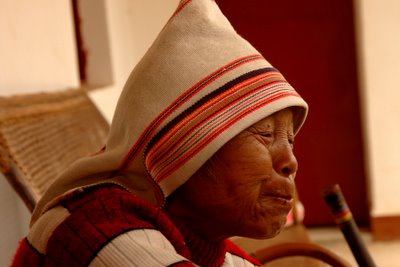
Here we are with our baijou friend and our fellow trekkers--an urban couple also teaching in China--who had "never hiked before" and who thought that "it's really interesting to see this highway construction." The Horror.

So we got the hell out of there and in two short flights were back in Lijiang from which we headed north to the mountains of the Yunnan-Tibet border. Here Ellen and Bei search for a place to stay in Zhongdian, about 4 hours north of Lijiang by bus. It was a joy to be back in the mountains, and at times we wondered why we ever left.

From Zhongdian we piled into a hired van with other foreigners for the 7 hour trip north to Deqin and its environs in the shadow of the incredible Meili Snow Mountains. Although not in Tibet proper, this area is dominated by Tibetans and is separated from the Tibet "Autonomous" Region by these mountains, some of which are unclimbed. We spent a night at Feilai Si, from which one famously views sunrise on the peaks (along with a host of other photo snapping tourists). From here, Ellen and Bei returned to Lijiang and I embarked on a 4-day hike into and around the small village of Yubeng at the foot of the mountains.

This yak systematically offered his thanks to Buddha at each stupa for the offerings that it then ate.

Yubeng is an incredible place--a tiny village huddled on a flat terrace beneath the glaciers of the sacred Mount Kawegabo. A waterfall at the toe of the glacier near the village draws pilgrims from far and wide, though I saw only one on this midwinter trip. This window is typical and decorates an equally beautiful home in the village.

A typical village house with the typical satellite TV dish found in the smallest villages throughout Yunnan (and undoubtedly throughout China). The unclimbed Mt. Kawegabo sparkles in the background under perfect skies soon to be replaced with short-lived snow squalls.
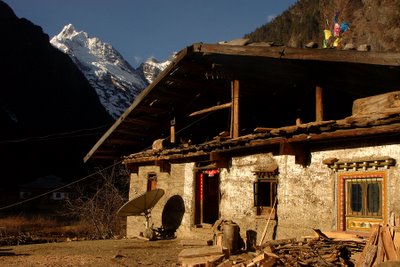
Yubeng, despite its small size, is a popular hiking destination and these horsepackers shuttle visitors in and out. I walked to Yubeng via an alternate route under my own power but met and socialized with a large group of Chinese from Beijing who rode horses for the 18 km standard approach. Village kids as young as 7 years old lead the horses up and down the mountain trail regularly.

A flock of birds near the sacred waterfall at the foot of Mt. Kawegabo.

Sunrise on Mt. Kawegabo from my guesthouse in Yubeng. Still unclimbed, this peak is said to be guarded by Gods and many climbers have lost their lives trying to gain the summit.
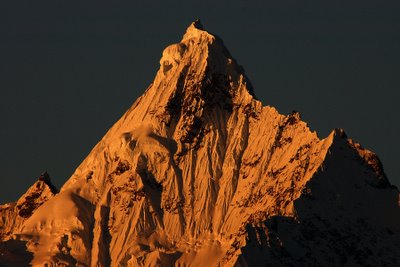
Sunset on Kawegabo from Feilai Si after my return from Yubeng and before returning south to Lijiang.
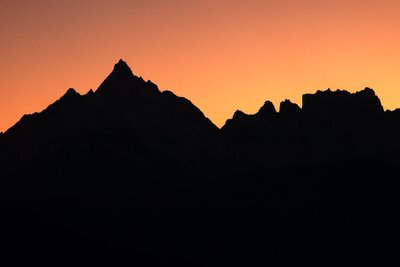
Next trip: hiking from Baoshan Stone Village to Lugu Lake. We leave on the 12th and return here around the 19th. Blogs should get more regular again after that...
We've been traveling for over a month now, for better or for worse, in sickness and in health, and now are in Lijiang briefly before heading out on our final excursion before classes start (yes, we will have to work again). Eventually, I'll post in detail on our adventures but for now here is a collection of photos from along the way and a little sense of where we've been. We're off shortly on one last trek and will start posting regularly once we return and get class preparation under control.
As Ellen jetted to Denver/Boulder/Laramie for a week's visit, Bei and I began our holiday journey with a quick (45 minute) flight from Lijiang to Kunming, the capitol of Yunnan, where we took advantage of the availability of western food and the dubious charms of a big city. Kunming is thriving and these salespeople were receiving a morning pep rally as Bei and I wandered by on our way to find a ride to the Bamboo Temple.

Alan Greenspan's legacy goes far beyond his accomplishments at the Fed. Here, on the eve of his retirement, his photograph, along with the newspaper that it is printed on, is taped to a temple window to protect busy monks from the distracting glare of the sun. You are not forgotten, Alan.

Kunming was but a waystation on our way to Thailand and Bei and I were soon airborne again for the two hour flight to Bangkok. We arrived after dark, hot and tired, and made our way to Khao San Rd. to find our guest house which was nearby but not on Khao San proper. As I struggled through throngs of dreadlocked "backpacker tourists" carrying a large climbing pack and a smaller pack and towing a tired Bei behind me, I heard a voice calling my name. Matt Williams, a Laramie climbing friend, is in Bangkok shooting photos at an AIDS hospice for children and happened to see me as I lumbered by. We met for dinner later in our stay. You can see Matt's excellent photographs at http://www.photoshelter.com/user/mathewphoto. The following day, Bei catches up on her sleep in the guesthouse lobby while I make arrangements for our travel north to Chiang Mai (this time by sleeper train).

Chiang Mai lies in the heart of the hill country of northern Thailand where I had promised Bei elephant rides. Elephants have been a traditional work animal in this part of Thailand and they are still used, though their value as a tourist attraction probably surpasses their ability to carry logs. To fulfill my promise we signed on for a tourist tour of the area near Chiang Mai and enjoyed a rather pedestrian day of elephant riding, bamboo raft floating and visits to small ethnic villages converted to centers for tourist sales. But it was fun and Bei was delighted by the elephant, which gently accepted sugar cane and bananas from her after she alerted him to food with a gentle tap to his ear as we rode.

Boldly, I took a stab at escaping Chiang Mai using a rented motor scooter. Riding in Chiang Mai traffic with a 4-year old is less than ideal and I was soon in a cold sweat despite the heat as I imagined Ellen's horror had she seen us hurtling down chaotic highways in a land where, disorientingly, they drive on the left side of the road. By the time we reached this temple on the edge of town, I'd had enough and stopped to chill out and regroup for the trip back into town. Bei was unperturbed and looked forward to the next leg of our journey. I wandered around the temple grounds sweating and figuring the odds of our returning the bike and ourselves unscathed to the rental place. Later I saw foreigners, scraped and shaken but otherwise ok, picking themselves up off the street after crashing their substantially larger machine.

Painted forked sticks apparently have religious significance and these were common on the temple grounds where they were arranged around trees that were themselves wrapped in sashes.

Back in Bangkok to meet Ellen after her whirlwind trip to the U.S., we found that Ronald MacDonald also has religious sensitivity in Thailand where he implores travelers to enter and pay homage to the quarter pounder.

Ellen arrived late at night at the Bangkok airport, where Bei and I met her, tired from a whirlwind week of socializing in Denver, Boulder and Laramie. The next day, we visited, of all places, Chinatown, where these pigs awaited conversion into Chinese food. Later we found our way into India-town where we enjoyed our first truly good Indian food since leaving the U.S. in July.

These fish decorated another area near Chinatown.

A typical Bangkok business, seen from the street.

Another short flight (1 hour) took us south to Krabi and a short longtail boat ride deposited us at Tonsai/Railay beach, our primary Thai destination for two weeks of climbing and swimming. I'd spent 2 months here in 1996 and Tonsai has changed. Once empty but for a small group of bamboo bungalows, the beach is now lined with restaurants and fancier bungalows and overwhelmed by throngs of climbers seething over everything from steep rock to espresso bars. Despite the changes, we had fun climbing easy routes (all we could manage) and swimming. Bei reveled in the availability of water (there is no pool in Lijiang) and swam almost continuously in the warm Andaman Sea and in the pool at our bungalow complex.

The climbing at Tonsai and Railay is unique in the world and though difficult routes were beyond us after 6 months away from rock, we could at least watch hard climbing while we sipped coconut shakes on the nearby restaurant patio. This local climber is working on one of the steep Tonsai routes. The tsunami a year ago surged higher than the climber in the photo (we are told), but this particular area was fortunate to have been sheltered by islands and reefs and damage was not severe (though people were certainly killed). Other nearby areas (e.g., Koh Pi Pi) were devastated.

Hanging on the rope was a regular posture for us as it was for this climber at Tonsai, though we managed to hang on much less difficult terrain.

Warning parents: brief nudity. The beautiful white sand beaches of southern Thailand are a magnet for vacationers from all over the world with a high concentration of European tourists used to the relatively liberal bathing suit norms of the Mediterranean Coast. Although Thais are offended by nudity, it is tolerated/ignored on the beaches of Railay, in part because this area is an isolated tourist area accessible only by boat. Though I refrained from pointing my telephoto lens at topless bathers, in the photo below Bei demonstrates the swimming scene at the beach.

A rest day adventure took us, again by motor scooter, though in sparse rural traffic, to the Tiger Cave temple area near Krabi where we explored beautiful forest, interesting monastic caves and an associated temple. Here Ellen and Bei check out one of the huge buttressed trees.

Another tree with religious sashes among the roots.

You parents will be relieved to see that riding motorcycles in foreign countries is perfectly safe for children. Here Bei demonstrates her safety equipment which nearly fit.

And here we are on our "big iron" returning from Tiger Cave with local/fellow "bikers" raucously showing their respect and comraderie. Photo by Ellen.

All tropical things must come to an end (or be consumed by decomposition) and with mixed feelings we left southern Thailand, returned to Bangkok, flew back to Kunming and then hopped by plane to the city of Jinghong in the Xishuangbanna region of southern Yunnan. Xishuangbanna had been described to us a "beautiful" and "interesting" but, though we did not spend enough time here to fairly pass judgement, the image of Marlon Brando muttering "the horror, the horror" as he sweated in his jungle kingdom kept echoing in my mind as we stumbled from road construction to village wife beatings to alcoholic ethnic ceremonies. Jinghong sits beside the Mekong River and the night market below was a hybrid of a carnival, a food market and a collection of seedy bars.

The food looked good, though I had already eaten by the time I wandered this market.

We rented bicycles (in China foreigners don't generally rent motorized vehicles) and rode through some nice countryside across the river from Jinghong.

The countryside around Jinghong is dominated by rice paddies in the flats and rubber tree plantations in the hills. Little original forest remains in this part of Xishuangbanna, though I read that further afield there is more to be found. A road connecting Bangkok to China is under construction here, and the construction follows the route of several popular treks as we were soon to discover.

We spent the Chinese New Year in Jinghong, where gifts like this fine coffee sampler were for sale. If any of you out there in Peets/Starbucks/Green Mountain-land are hankering after some fine instant Nescafe, just drop me an e-mail and I'll see what I can ship you. My best description of Chinese New Year is that it evokes the feeling one must have had in London during WWII when the German's were bombing heavily.

Escaping the city and getting out on foot is always the solution to travel weariness and we set off with enthusiasm and a local English-speaking guide (who told us that he "loved nature") on a two-day trek that promised "rice paddies, jungle, and ethnic villages." Here we are on day one of our trek, enjoying the heavy equipment of the Bangkok to China highway. The horror; The horror.

This kind lady, who reminded me of the flying monkeys from the Wizard of Oz (which we were reading to Bei at the time), welcomed us onto her patio for snacks and the local moonshine, called baijou (a "wine" typically made from sorghum or corn with an alcohol content of about 50%). She could toss back some of the latter with a grimace and an impish laugh and she was a good sharer.

Here we are with our baijou friend and our fellow trekkers--an urban couple also teaching in China--who had "never hiked before" and who thought that "it's really interesting to see this highway construction." The Horror.

So we got the hell out of there and in two short flights were back in Lijiang from which we headed north to the mountains of the Yunnan-Tibet border. Here Ellen and Bei search for a place to stay in Zhongdian, about 4 hours north of Lijiang by bus. It was a joy to be back in the mountains, and at times we wondered why we ever left.

From Zhongdian we piled into a hired van with other foreigners for the 7 hour trip north to Deqin and its environs in the shadow of the incredible Meili Snow Mountains. Although not in Tibet proper, this area is dominated by Tibetans and is separated from the Tibet "Autonomous" Region by these mountains, some of which are unclimbed. We spent a night at Feilai Si, from which one famously views sunrise on the peaks (along with a host of other photo snapping tourists). From here, Ellen and Bei returned to Lijiang and I embarked on a 4-day hike into and around the small village of Yubeng at the foot of the mountains.

This yak systematically offered his thanks to Buddha at each stupa for the offerings that it then ate.

Yubeng is an incredible place--a tiny village huddled on a flat terrace beneath the glaciers of the sacred Mount Kawegabo. A waterfall at the toe of the glacier near the village draws pilgrims from far and wide, though I saw only one on this midwinter trip. This window is typical and decorates an equally beautiful home in the village.

A typical village house with the typical satellite TV dish found in the smallest villages throughout Yunnan (and undoubtedly throughout China). The unclimbed Mt. Kawegabo sparkles in the background under perfect skies soon to be replaced with short-lived snow squalls.

Yubeng, despite its small size, is a popular hiking destination and these horsepackers shuttle visitors in and out. I walked to Yubeng via an alternate route under my own power but met and socialized with a large group of Chinese from Beijing who rode horses for the 18 km standard approach. Village kids as young as 7 years old lead the horses up and down the mountain trail regularly.

A flock of birds near the sacred waterfall at the foot of Mt. Kawegabo.

Sunrise on Mt. Kawegabo from my guesthouse in Yubeng. Still unclimbed, this peak is said to be guarded by Gods and many climbers have lost their lives trying to gain the summit.

Sunset on Kawegabo from Feilai Si after my return from Yubeng and before returning south to Lijiang.

Next trip: hiking from Baoshan Stone Village to Lugu Lake. We leave on the 12th and return here around the 19th. Blogs should get more regular again after that...

0 Comments:
Post a Comment
<< Home